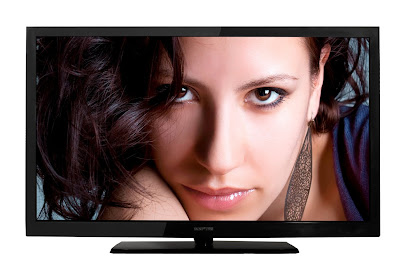- Back to Home »
- Articles , best lcd tv , LCD television , LCD television Basic LCD concepts , lcd tv , LCD tv. »
- LCD television Basic LCD concepts
Posted by : lcd
Wednesday, April 17, 2013
LCD television
Basic LCD concepts

LCD televisions produce a black and colored image by selectively filtering a white light. The light is typically provided by a series of cold cathode fluorescent lamps (CCFLs) at the back of the screen, although some displays use white or colored LEDs instead. Millions of individual LCD shutters, arranged in a grid, open and close to allow a metered amount of the white light through. Each shutter is paired with a colored filter to remove all but the red, green or blue (RGB) portion of the light from the original white source. Each shutter–filter pair forms a single sub-pixel. The sub-pixels are so small that when the display is viewed from even a short distance, the individual colors blend together to produce a single spot of color, a pixel. The shade of color is controlled by changing the relative intensity of the light passing through the sub-pixels.
Liquid crystals encompass a wide range of (typically) rod-shaped polymers that naturally form into thin, ordered layers, as opposed to the more random alignment of a normal liquid. Some of these, the nematic liquid crystals, also show an alignment effect between the layers. The particular direction of the alignment of a nematic liquid crystal can be set by placing it in contact with an alignment layer or director, which is essentially a material with microscopic grooves in it, on the supporting substrates. When placed on a director, the layer in contact will align itself with the grooves, and the layers above will subsequently align themselves with the layers below, the bulk material taking on the director's alignment. In the case of a Twisted Nematic (TN) LCD, this effect is utilized by using two directors arranged at right angles and placed close together with the liquid crystal between them. This forces the layers to align themselves in two directions, creating a twisted structure with each layer aligned at a slightly different angle to the ones on either side.
LCD shutters consist of a stack of three primary elements. On the bottom and top of the shutter are polarizer plates set at right angles. Normally light cannot travel through a pair of polarizers arranged in this fashion, and the display would be black. The polarizers also carry the directors to create the twisted structure aligned with the polarizers on either side. As the light flows out of the rear polarizer, it will naturally follow the liquid crystal's twist, exiting the front of the liquid crystal having been rotated through the correct angle, that allows it to pass through the front polarizer. LCDs are normally transparent in this mode of operation.
To turn a shutter off, a voltage is applied across it from front to back. The rod-shaped molecules align themselves with the electric field instead of the directors, distorting the twisted structure. The light no longer changes polarization as it flows through the liquid crystal, and can no longer pass through the front polarizer. By controlling the voltage applied across the liquid crystal, the amount of remaining twist can be selected. This allows the transparency of the shutter to be controlled. To improve switching time, the cells are placed under pressure, which increases the force to re-align themselves with the directors when the field is turned off.
Several other variations and modifications have been used in order to improve performance in certain applications. In-Plane Switching displays (IPS and S-IPS) offer wider viewing angles and better color reproduction, but are more difficult to construct and have slightly slower response times. IPS displays are used primarily for computer monitors. Vertical Alignment (VA, S-PVA and MVA) offer higher contrast ratios and good response times, but suffer from color shifting when viewed from the side. In general, all of these displays work in a similar fashion by controlling the polarization of the light source.










